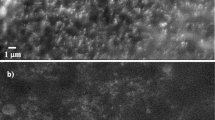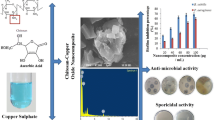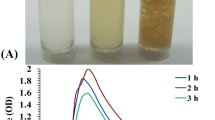Abstract
Synthesis of nanocomposites from antimicrobial biopolymers such as chitosan (CS) and lysozyme (LZ) is an important and promising area in bionanotechnology. Chitosan–lysozyme (CS–LZ) nanoparticles (NPs) were prepared by the nanoprecipitation method, using commercial chitosan of 153 kDa. TEM and dynamic light scattering (DLS) analysis were carried out to evaluate the morphology, size, dispersion, and Z potential. Association efficiency of lysozyme was determined using Coomassie blue assay. The antifungal activity of NPs against Aspergillus parasiticus was evaluated through cell viability (XTT), germination and morphometry of spores, and reducing sugars production; the effects on membrane integrity and cell wall were also analyzed. NPs’ size were found in the range of 13.4 and 11.8 nm for CS–LZ and CS NPs, respectively, and high Z potential value was observed in both NPs. Also, high association of lysozyme was presented in the CS matrix. With respect to the biological responses, CS–LZ NPs reduced the viability of A. parasiticus and a strong inhibitory effect on the germination of spores (100% of inhibition) was observed at 24 h in in vitro assays. CS–LZ and CS NPs affected the membrane integrity and the cell wall of spores of fungi with respect to control, which is consistent with the low amount of reducing sugars detected. CS–LZ NPs prepared by nanoprecipitation promise to be a viable and safe alternative for use in biological systems, with a possible low or null impact to humans and biota. However, the potential benefits and the environmental and health implications of NPs need to be globally discussed due to its possible negative effects.





Similar content being viewed by others
Abbreviations
- CS–LZ:
-
Chitosan–lysozyme
- NPs:
-
Nanoparticles
- CS:
-
Chitosan
- LZ:
-
Lysozyme
- TEM:
-
Transmission electron microscopy
- DLS:
-
Dynamic light scattering
- XTT:
-
Tetrazolium salt
- Mw:
-
Molecular weight
- ROS:
-
Reactive oxygen species
- kDa:
-
Kilo Daltons
- PDA:
-
Potato dextrose agar
- µg/mL:
-
Microgram per milliliter
- BSA:
-
Bovine serum albumin
- PI:
-
Propidium ioidide
- CW:
-
Calcofluor-white
- CS:
-
Chitosan of 153 kDa
References
Aranda-Martinez A, Lopez-Moya F, Lopez-Llorca LV (2016) Cell wall composition plays a key role on sensitivity of filamentous fungi to chitosan. J Basic Microbiol 56:1059–1070
Benhabiles M, Salah R, Lounici H, Drouiche N, Goosen M, Mameri N (2012) Antibacterial activity of chitin, chitosan and its oligomers prepared from shrimp shell waste. Food Hydrocol 29:48–56
Bernard M, Latgé J-P (2001) Aspergillus fumigatus cell wall: composition and biosynthesis. Med Mycol 39:9–17
Bilati U, Allémann E, Doelker E (2005) Development of a nanoprecipitation method intended for the entrapment of hydrophilic drugs into nanoparticles. Eur J Pharm Sci 24:67–75
Buitimea-Cantúa GV, Rosas-Burgos EC, Cinco-Moroyoqui FJ, Burgos-Hernández A, Plascencia-Jatomea M, Cortez-Rocha MO, Gálvez-Ruiz JC (2013) In vitro effect of antifungal fractions from the plants baccharis glutinosa and jacquinia macrocarpa on chitin and β-1, 3-glucan hydrolysis of maize phytopathogenic fungi and on the fungal β-1, 3-glucanase and chitinase activities. J Food Saf 33:526–535
Camacho Elizondo M, Vega Baudrit J, Campos Gallo A (2011) Uso de nanomateriales en polímeros para la obtención de bioempaques en aplicaciones alimentarias. Revista de la Sociedad Química del Perú 77:292–306
Charernsriwilaiwat N, Opanasopit P, Rojanarata T, Ngawhirunpat T (2012) Lysozyme-loaded, electrospun chitosan-based nanofiber mats for wound healing. Int J Pharm 427:379–384
Chavan PS, Tupe SG (2014) Antifungal activity and mechanism of action of carvacrol and thymol against vineyard and wine spoilage yeasts. Food Control 46:115–120
Choi O, Deng KK, Kim N-J, Ross L, Surampalli RY, Hu Z (2008) The inhibitory effects of silver nanoparticles, silver ions, and silver chloride colloids on microbial growth. Water Res 42:3066–3074
Cota-Arriola O, Cortez-Rocha MO, Ezquerra-Brauer JM, Lizardi-Mendoza J, Burgos-Hernández A, Robles-Sánchez RM, Plascencia-Jatomea M (2013a) Ultrastructural, morphological, and antifungal properties of micro and nanoparticles of chitosan crosslinked with sodium tripolyphosphate. J Polym Environ 21:971–980
Cota-Arriola O, Onofre Cortez-Rocha M, Burgos-Hernández A, Marina Ezquerra-Brauer J, Plascencia-Jatomea M (2013b) Controlled release matrices and micro/nanoparticles of chitosan with antimicrobial potential: development of new strategies for microbial control in agriculture. J Sci Food Agric 93:1525–1536
Cota-Arriola O et al (2016) Preparation of chitosan matrices with ferulic acid: physicochemical characterization and relationship on the growth of Aspergillus parasiticus. CyTA-J Food 15(1):65–74. doi:10.1080/19476337.2016.1213317
Datta S, Christena LR, Rajaram YRS (2013) Enzyme immobilization: an overview on techniques and support materials 3. Biotech 3:1–9. doi:10.1007/s13205-012-0071-7
Deng Q-Y, Zhou C-R, Luo B-H (2006) Preparation and characterization of chitosan nanoparticles containing lysozyme. Pharm Biol 44:336–342
Durango A, Soares N, Benevides S, Teixeira J, Carvalho M, Wobeto C, Andrade N (2006) Development and evaluation of an edible antimicrobial film based on yam starch and chitosan. Packag Technology Sci 19:55–59
El Guilli M, Hamza A, Clément C, Ibriz M, Ait Barka E (2016) Effectiveness of postharvest treatment with chitosan to control citrus green mold. Agriculture 6:12
Hadwiger L, Kendra D, Fristensky B, Wagoner W (1986) Chitosan both activates genes in plants and inhibits RNA synthesis in fungi. In: Muzzarelli R, Jeuniaux C, Gooday GW (eds) Chitin in nature and technology. Springer, Boston, MA, pp 209–214
Hirano S, Nagao N (1989) Effects of chitosan, pectic acid, lysozyme, and chitinase on the growth of several phytopathogens. Agric Biol Chem 53:3065–3066
Hirano S, Yamaguchi R, Fukui N, Iwata M (1990) A chitosan oxalate gel: its conversion to an N-acetylchitosan gel via a chitosan gel. Carbohyd Res 201:145–149
Hu Y-L, Qi W, Han F, Shao J-Z, Gao J-Q (2011) Toxicity evaluation of biodegradable chitosan nanoparticles using a zebrafish embryo model. Int J Nanomed 6:3351–3359
Huang W, Xu H, Xue Y, Huang R, Deng H, Pan S (2012) Layer-by-layer immobilization of lysozyme–chitosan–organic rectorite composites on electrospun nanofibrous mats for pork preservation. Food Res Int 48:784–791
Huang S, Wang J, Zhang Y, Yu Z, Qi C (2016) Quaternized carboxymethyl chitosan-based silver nanoparticles hybrid: microwave-assisted synthesis. Charact Antibact Act Nanomat 6:118
Klis F, Ram A, De Groot P (2007) A molecular and genomic view of the fungal cell wall. In: Howard RJ, Gow NAR (eds) Biology of the fungal cell. Springer, Heidelberg, pp 97–120
Li W-R, Xie X-B, Shi Q-S, Zeng H-Y, You-Sheng O-Y, Chen Y-B (2010) Antibacterial activity and mechanism of silver nanoparticles on Escherichia coli. Appl Microbiol Biotechnol 85:1115–1122
Lian Z-X, Ma Z-S, Wei J, Liu H (2012) Preparation and characterization of immobilized lysozyme and evaluation of its application in edible coatings. Process Biochem 47:201–208
Lin C-W, Chen L-J, Lee P-L, Lee C-I, Lin J-C, Chiu J-J (2007) The inhibition of TNF-α-induced E-selectin expression in endothelial cells via the JNK/NF-κB pathways by highly N-acetylated chitooligosaccharides. Biomaterials 28:1355–1366
Luque-Alcaraz AG et al (2012) Characterization and antiproliferative activity of nobiletin-loaded chitosan nanoparticles. J Nanomater 2012:100
Luque-Alcaraz AG et al (2016) Enhanced antifungal effect of chitosan/pepper tree (Schinus molle) essential oil bionanocomposites on the viability of Aspergillus parasiticus spores. J Nanomater 2016:38
Manke A, Wang L, Rojanasakul Y (2013) Mechanisms of nanoparticle-induced oxidative stress and toxicity. BioMed Res Int 2013:15. doi:10.1155/2013/942916
Martínez-Robles ÁM et al (2016) Antimicrobial properties of biofunctionalized silver nanoparticles on clinical isolates of streptococcus mutans and its serotypes. Nanomaterials 6:136
Medina-López CF, Plascencia-Jatomea M, Cinco-Moroyoqui FJ, Yépiz-Gómez MS, Cortez-Rocha MO, Rosas-Burgos EC (2016) Potentiation of antifungal effect of a mixture of two antifungal fractions obtained from Baccharis glutinosa and Jacquinia macrocarpa plants. J Environ Sci Health 51:760–768
Meletiadis J, Mouton JW, Meis JF, Bouman BA, Donnelly JP, Verweij PE, Network E (2001) Colorimetric assay for antifungal susceptibility testing of aspergillus species. J Clin Microbiol 39:3402–3408
Nel A, Xia T, Mädler L, Li N (2006) Toxic potential of materials at the nanolevel. science 311:622–627
Ojijo V, Ray SS (2013) Processing strategies in bionanocomposites. Prog Polym Sci 38:1543–1589
Park P-J, Je J-Y, Byun H-G, Moon S-H, Kim S-K (2004) Antimicrobial activity of hetero-chitosans and their oligosaccharides with different molecular weights. J Microbiol Biotechnol 14:317–323
Patel S, Jammalamadaka U, Sun L, Tappa K, Mills DK (2015) Sustained release of antibacterial agents from doped halloysite nanotubes. Bioengineering 3:1
Piras AM, Maisetta G, Sandreschi S, Esin S, Gazzarri M, Batoni G, Chiellini F (2014) Preparation, physical–chemical and biological characterization of chitosan nanoparticles loaded with lysozyme. Int J Biol Macromol 67:124–131
Plascencia-Jatomea M, Viniegra G, Olayo R, Castillo-Ortega MM, Shirai K (2003) Effect of chitosan and temperature on spore germination of Aspergillus niger. Macromol Biosci 3:582–586
Plascencia-Jatomea S, Gómez Y, Vales-Haro J (2014) Aspergillus spp. (Black Mold). In: Bautista-Baños S (ed) Postharvest decay: control strategies. Elsevier Inc., Academic Press, New York, pp 267–286
Qun G, Ajun W (2006) Effects of molecular weight, degree of acetylation and ionic strength on surface tension of chitosan in dilute solution. Carbohyd Polym 64:29–36
Rahman MH, Hjeljord LG, Aam BB, Sørlie M, Tronsmo A (2015) Antifungal effect of chito-oligosaccharides with different degrees of polymerization. Eur J Plant Pathol 141:147–158
Ren D, Yi H, Wang W, Ma X (2005) The enzymatic degradation and swelling properties of chitosan matrices with different degrees of N-acetylation. Carbohyd Res 340:2403–2410
Rhim J-W, Park H-M, Ha C-S (2013) Bio-nanocomposites for food packaging applications. Prog Polym Sci 38:1629–1652
Riccardi C, Nicoletti I (2006) Analysis of apoptosis by propidium iodide staining and flow cytometry. Nat Protoc 1:1458–1461
Saharan V et al (2015) Synthesis and in vitro antifungal efficacy of Cu–chitosan nanoparticles against pathogenic fungi of tomato. Int J Biol Macromol 75:346–353
Salazar O, Asenjo JA (2007) Enzymatic lysis of microbial cells. Biotechnol lett 29:985–994
Wang S, Ng TB, Chen T, Lin D, Wu J, Rao P, Ye X (2005) First report of a novel plant lysozyme with both antifungal and antibacterial activities. Biochem Biophys Res Commun 327:820–827
Wang Y, Li P, Truong-Dinh Tran T, Zhang J, Kong L (2016) Manufacturing techniques and surface engineering of polymer based nanoparticles for targeted drug delivery to cancer. Nanomaterials 6:26
Wu Z, Zhang B, Yan B (2009) Regulation of enzyme activity through interactions with nanoparticles. Int J Mol Sci 10:4198–4209
Wu T, Wu C, Fu S, Wang L, Yuan C, Chen S, Hu Y (2017) Integration of lysozyme into chitosan nanoparticles for improving antibacterial activity. Carbohyd Polym 155:192–200
Xu Y, Du Y (2003) Effect of molecular structure of chitosan on protein delivery properties of chitosan nanoparticles. Int J Pharm 250:215–226
Xu H, Nobile CJ, Dongari-Bagtzoglou A (2013) Glucanase induces filamentation of the fungal pathogen Candida albicans. PloS One 8:e63736
Yang H, Liu C, Yang D, Zhang H, Xi Z (2009) Comparative study of cytotoxicity, oxidative stress and genotoxicity induced by four typical nanomaterials: the role of particle size, shape and composition. J Appl Toxicol 29:69–78
Yien L, Zin NM, Sarwar A, Katas H (2012) Antifungal activity of chitosan nanoparticles and correlation with their physical properties. Int J Biomater 2012:9. doi:10.1155/2012/632698
Yuceer M, Caner C (2014) Antimicrobial lysozyme–chitosan coatings affect functional properties and shelf life of chicken eggs during storage. J Sci Food Agric 94:153–162
Zhang X, Zhao J, Wen Y, Zhu C, Yang J, Yao F (2013) Carboxymethyl chitosan-poly (amidoamine) dendrimer core–shell nanoparticles for intracellular lysozyme delivery. Carbohyd Polym 98:1326–1334
Zhang L, Liu T, Xiao Y, Yu D, Zhang N (2015) Hyaluronic acid-chitosan nanoparticles to deliver Gd-DTPA for MR cancer imaging. Nanomaterials 5:1379–1396
Zimoch-Korzycka A, Gardrat C, Castellan A, Coma V, Jarmoluk A (2015) The use of lysozyme to prepare biologically active chitooligomers. Polímeros 25:35–41
Acknowledgements
The study was funded by the Mexican Council for Science and Technology (CONACyT) through the project No. 219786 (CB-2013-01) and for the scholarship to Cynthia Nazareth Hernández-Téllez for postgraduate studies. The authors acknowledge the University of Sonora for the assistantship grant to Francisco Julián Rodríguez-Córdova for undergraduate studies.
Author information
Authors and Affiliations
Contributions
Maribel Plascencia-Jatomea conceived and designed the experiments. Cynthia Nazareth Hernández-Téllez, Francisco Julián Rodríguez-Córdova and Aaron Martínez-Higuera performed the experiments. Ema Carina Rosas Burgos, Mario Onofre Cortez-Rocha, Armando Burgos-Hernández, Wilfrido Torres-Arreola and Jaime Lizardi-Mendoza analyzed the data and contributed with reagents, materials and analysis tools. Cynthia Nazareth Hernández-Téllez and Maribel Plascencia-Jatomea wrote the paper.
Corresponding author
Ethics declarations
Conflict of interest
The authors declare no conflict of interest.
Rights and permissions
About this article
Cite this article
Hernández-Téllez, C.N., Rodríguez-Córdova, F.J., Rosas-Burgos, E.C. et al. Activity of chitosan–lysozyme nanoparticles on the growth, membrane integrity, and β-1,3-glucanase production by Aspergillus parasiticus . 3 Biotech 7, 279 (2017). https://doi.org/10.1007/s13205-017-0913-4
Received:
Accepted:
Published:
DOI: https://doi.org/10.1007/s13205-017-0913-4




